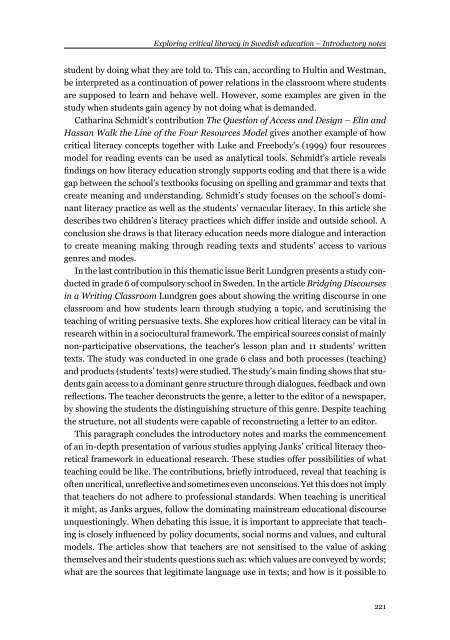Download issue - Umeå universitet
Download issue - Umeå universitet
Download issue - Umeå universitet
Create successful ePaper yourself
Turn your PDF publications into a flip-book with our unique Google optimized e-Paper software.
Exploring critical literacy in Swedish education – Introductory notes<br />
student by doing what they are told to. This can, according to Hultin and Westman,<br />
be interpreted as a continuation of power relations in the classroom where students<br />
are supposed to learn and behave well. However, some examples are given in the<br />
study when students gain agency by not doing what is demanded.<br />
Catharina Schmidt’s contribution The Question of Access and Design – Elin and<br />
Hassan Walk the Line of the Four Resources Model gives another example of how<br />
critical literacy concepts together with Luke and Freebody’s (1999) four resources<br />
model for reading events can be used as analytical tools. Schmidt’s article reveals<br />
findings on how literacy education strongly supports coding and that there is a wide<br />
gap between the school’s textbooks focusing on spelling and grammar and texts that<br />
create meaning and understanding. Schmidt’s study focuses on the school’s dominant<br />
literacy practice as well as the students’ vernacular literacy. In this article she<br />
describes two children’s literacy practices which differ inside and outside school. A<br />
conclusion she draws is that literacy education needs more dialogue and interaction<br />
to create meaning making through reading texts and students’ access to various<br />
genres and modes.<br />
In the last contribution in this thematic <strong>issue</strong> Berit Lundgren presents a study conducted<br />
in grade 6 of compulsory school in Sweden. In the article Bridging Discourses<br />
in a Writing Classroom Lundgren goes about showing the writing discourse in one<br />
classroom and how students learn through studying a topic, and scrutinising the<br />
teaching of writing persuasive texts. She explores how critical literacy can be vital in<br />
research within in a sociocultural framework. The empirical sources consist of mainly<br />
non-participative observations, the teacher’s lesson plan and 11 students’ written<br />
texts. The study was conducted in one grade 6 class and both processes (teaching)<br />
and products (students’ texts) were studied. The study’s main finding shows that students<br />
gain access to a dominant genre structure through dialogues, feedback and own<br />
reflections. The teacher deconstructs the genre, a letter to the editor of a newspaper,<br />
by showing the students the distinguishing structure of this genre. Despite teaching<br />
the structure, not all students were capable of reconstructing a letter to an editor.<br />
This paragraph concludes the introductory notes and marks the commencement<br />
of an in-depth presentation of various studies applying Janks’ critical literacy theoretical<br />
framework in educational research. These studies offer possibilities of what<br />
teaching could be like. The contributions, briefly introduced, reveal that teaching is<br />
often uncritical, unreflective and sometimes even unconscious. Yet this does not imply<br />
that teachers do not adhere to professional standards. When teaching is uncritical<br />
it might, as Janks argues, follow the dominating mainstream educational discourse<br />
unquestioningly. When debating this <strong>issue</strong>, it is important to appreciate that teaching<br />
is closely influenced by policy documents, social norms and values, and cultural<br />
models. The articles show that teachers are not sensitised to the value of asking<br />
themselves and their students questions such as: which values are conveyed by words;<br />
what are the sources that legitimate language use in texts; and how is it possible to<br />
221

















